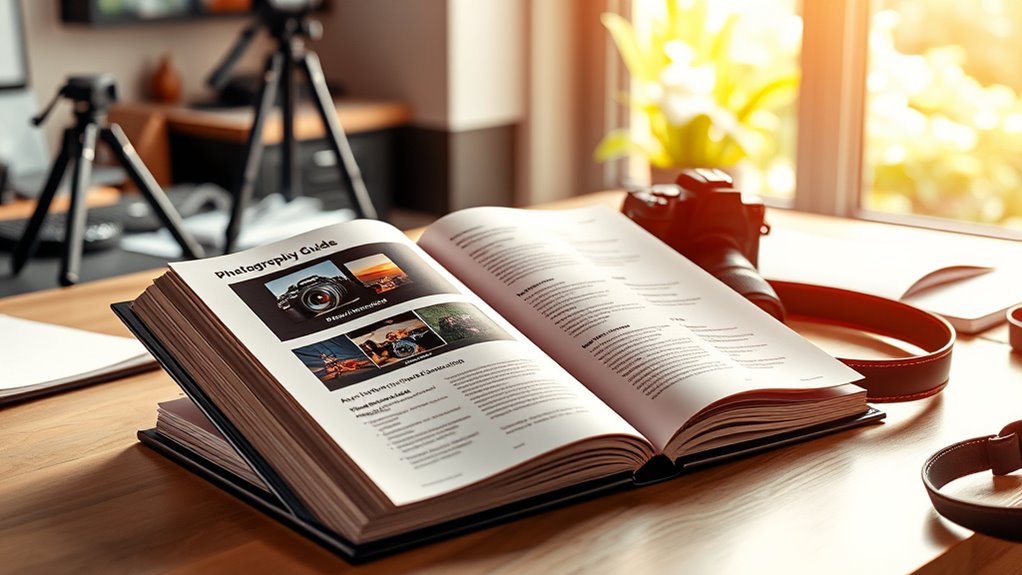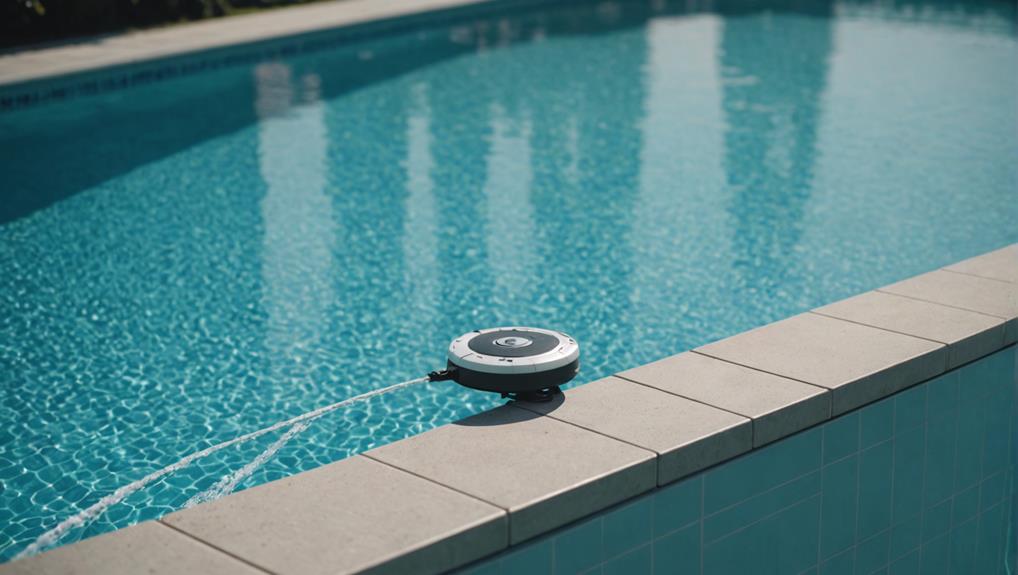If you want to improve your photography skills in 2025, I recommend checking out some top guide books. From beginner-friendly options like the National Geographic Photo Basics Guide to genre-specific guides such as street photography and astrophotography, there’s something for everyone. Extensive courses and pose collections can also boost your creativity. Keep exploring these resources, and you’ll discover tips and techniques to elevate your photography game even further.
Key Takeaways
- The list covers beginner, genre-specific, and advanced photography books for diverse skill levels and interests.
- It includes practical guides on core concepts, composition, posing, and specialized fields like astrophotography and street photography.
- Many titles combine technical instruction with creative inspiration, suitable for hobbyists and aspiring professionals.
- The selection emphasizes accessibility, offering resources for quick reference, comprehensive learning, and city or nature photography.
- Updated for 2025, these guides reflect current trends and user-friendly approaches to elevate photography skills.
National Geographic Photo Basics Guide

If you’re just starting out in photography and want a thorough yet accessible guide, the National Geographic Photo Basics Guide is an excellent choice. I found it incredibly helpful for understanding core concepts like focus, exposure, framing, and lighting—whether you’re using a digital camera or your smartphone. The book breaks down complex ideas like F-stops and composition into simple, practical advice that applies across many styles, from family and pet photos to travel and street scenes. Plus, it includes behind-the-lens stories and pro tips that inspire you to improve your skills and see the creative possibilities in every shot.
Best For: Beginners and hobbyists looking for a comprehensive, easy-to-understand guide to improve their photography skills across various styles using both digital cameras and smartphones.
Pros:
- Clear explanations of fundamental concepts like focus, exposure, and lighting tailored for beginners
- Practical advice applicable to diverse photography styles such as family, pet, travel, and street scenes
- Includes behind-the-lens stories and professional tips from National Geographic photographer Joel Sartore for inspiration and insight
Cons:
- Might lack advanced techniques needed for professional-level photography
- Some readers may find the coverage of specialized techniques like infrared and astrophotography too brief
- As a beginner-focused guide, it may not delve deeply into complex camera settings or editing workflows
Focus on Street Photography: A Creative Guide for Beginners and Enthusiasts

Focus on Street Photography: A Creative Guide for Beginners and Enthusiasts is an ideal choice for anyone enthusiastic to develop their urban photography skills through a practical and personal approach. I love how it emphasizes moving beyond spontaneous snapshots to create intentional, compelling images. The book covers essential techniques like using light, shadow, and composition to tell stories. It offers tips on blending in, approaching strangers, and shooting discreetly, whether in black and white or color. Plus, the gear advice suits various budgets, and the cultural insights and creative prompts keep me inspired on every street walk. It’s a detailed guide to capturing authentic city moments.
Best For: beginners, hobbyists, and travelers eager to develop their urban photography skills through practical tips, creative prompts, and cultural insights.
Pros:
- Offers comprehensive techniques on light, shadow, and composition for storytelling
- Provides personalized gear suggestions suitable for various budgets
- Includes creative prompts and cultural context to inspire ongoing practice
Cons:
- May require additional resources or classes for advanced technical skills
- Focus primarily on urban street photography, limiting scope for other genres
- Some readers might find the personal anecdotes less applicable to their local environments
Digital Photography Complete Course

The Digital Photography Complete Course by DK stands out as an ideal choice for beginners and aspiring photographers enthusiastic to build a solid foundation in digital imaging. I appreciate how it offers a thorough 20-week program that covers essential skills, from mastering camera functions to creating professional-quality images. The course combines straightforward tutorials, clear diagrams, and practical assignments that make complex concepts like aperture, exposure, and shutter speed easy to understand. I found the step-by-step photo shoots and Q&As especially helpful for building confidence and experimenting with techniques. This course truly equips you to elevate your photography skills and develop your unique style.
Best For: beginners and aspiring photographers seeking a comprehensive, easy-to-follow digital photography course to build foundational skills and confidence.
Pros:
- Offers a thorough 20-week program combining tutorials, practical assignments, and photo shoots for well-rounded learning
- Uses clear diagrams and illustrations to simplify complex technical concepts like aperture, exposure, and shutter speed
- Focuses on developing creative and technical skills to produce professional-quality images
Cons:
- May require dedication over an extended period to complete the full course
- Some learners might find the breadth of topics overwhelming without prior photography experience
- As a book-based course, it may lack interactive elements found in live or online classes
Photography 101 Pocket Guide

Whether you’re just starting out or looking to solidify your basics, the Photography 101 Pocket Guide is an essential resource. It covers pre-shoot preparation with checklists, helping you confirm your camera setup and understand key modes and settings. I find its clear explanations of exposure components—aperture, shutter speed, and ISO—especially helpful for controlling light and brightness. The guide also explains lens choices and focal lengths, showing how they influence perspective. Plus, it offers practical composition tips and tailored techniques for portraits, landscapes, action shots, and low-light scenarios. This compact guide boosts confidence and skills for capturing great photos in any situation.
Best For: Beginners and hobbyists looking to improve their photography skills with a concise, easy-to-follow resource.
Pros:
- Clear explanations of fundamental concepts like exposure and focal length
- Practical checklists and techniques for various shooting scenarios
- Compact and portable, ideal for quick reference on the go
Cons:
- May not cover advanced photography topics in depth
- Limited detail for experienced photographers seeking advanced tips
- Focuses primarily on basic principles, which might oversimplify complex situations
National Geographic Photo Basics Guide

If you’re new to photography or want a solid foundation, the National Geographic Photo Basics Guide is an excellent choice. I found it incredibly helpful for understanding essentials like choosing gear, mastering focus, exposure, framing, and lighting. It covers both digital cameras and smartphones, making it versatile for any situation. The book dives into basic concepts like F-stops, composition, and camera settings, applicable across family, travel, pet, and nature photography. I especially appreciated the practical tips, behind-the-scenes stories from Joel Sartore, and specialized techniques like astrophotography. It’s a clear, engaging resource that transforms theory into real-world skills.
Best For: beginners and amateur photographers seeking a comprehensive, easy-to-understand guide to improve their photography skills across various styles and equipment.
Pros:
- Covers both digital cameras and smartphones, offering versatile advice for different devices
- Includes practical tips, behind-the-scenes stories, and specialized techniques like astrophotography
- Engaging, straightforward writing that simplifies complex concepts for beginners
Cons:
- May lack in-depth technical details for advanced photographers
- Focuses primarily on fundamental techniques, less on advanced editing or post-processing skills
- Some readers might find it too basic if they already have some photography experience
The Photographers Guide to Posing: Techniques to Flatter Everyone

Photographers looking to elevate their portrait work will find “The Photographers Guide to Posing: Techniques to Flatter Everyone” especially valuable, as it offers practical strategies for creating natural, flattering poses. I’ve learned that mastering posing is essential, even if your lighting and composition are perfect. Understanding camera perspective and avoiding common mistakes—like awkward hand placement or poor posture—can dramatically improve results. The book emphasizes starting with a base pose and building from there, tailoring poses for different subjects, from individuals to groups. Analyzing and refining poses continuously helps me produce confident, engaging images that flatter every subject I photograph.
Best For: photographers seeking to improve their posing skills and create natural, flattering images for clients of all ages and group sizes.
Pros:
- Provides practical, step-by-step techniques for flattering poses across various subjects.
- Emphasizes the importance of understanding camera perspective and avoiding common mistakes.
- Offers strategies for analyzing and refining poses to develop endless creative options.
Cons:
- May require dedicated practice to master the foundational posing techniques.
- Focuses primarily on portrait and group posing, with less emphasis on other photography styles.
- Some readers might find the detailed chapters on subject-specific posing less applicable if they specialize in niche areas.
Affordable Astrophotography For Beginners

Affordable astrophotography is entirely within reach for beginners who want to explore the night sky without breaking the bank. You don’t need expensive gear—smartphones and tripods are enough for basic shots like the moon and star trails. The key is understanding simple techniques and using affordable equipment such as entry-level cameras, lenses, and DIY star trackers. I’ve found that mastering camera settings like ISO and shutter speed makes a huge difference. With some planning, patience, and practice, you can capture stunning celestial images without a hefty investment. This hobby truly opens a window to the universe, and you don’t have to be a pro to get started.
Best For: Beginners interested in exploring astrophotography on a budget, using basic equipment like smartphones and tripods to capture celestial objects.
Pros:
- Affordable entry point with minimal equipment costs
- Easy to learn with straightforward techniques and settings
- Encourages experimentation and personal growth in photography skills
Cons:
- Limited ability to capture deep-sky objects or high-detail images
- May require longer exposure times and patience for good results
- Less capability to compensate for light pollution and atmospheric conditions
The Beginners Photography Guide

The Beginners Photography Guide stands out as an ideal resource for complete novices enthusiastic to understand their cameras and improve their skills. I find it perfect for those starting with digital photography, offering simple explanations of camera jargon, settings, and fundamental concepts. The book emphasizes mastering exposure—aperture, shutter speed, and ISO—so you can control your images creatively. With clear tutorials, illustrations, and practical exercises, it encourages experimentation and troubleshooting. Whether you’re shifting from film or just want to boost your confidence beyond auto mode, this guide provides a solid foundation to elevate your photography skills with ease and clarity.
Best For: Beginners eager to learn digital photography fundamentals and improve their confidence in camera controls.
Pros:
- Clear, simple explanations suitable for complete novices
- Includes practical exercises and tutorials to encourage hands-on learning
- Emphasizes mastering exposure for creative control and technical skill development
Cons:
- May lack advanced techniques for more experienced photographers
- Some users note minor issues with used copies or pricing variations
- Focus primarily on basic concepts, less comprehensive on specialized photography styles
The Photo Hustle: Photography Business Guide

If you’re looking to turn your passion for photography into a profitable business, “The Photo Hustle: Photography Business Guide” is an essential resource. I found it incredibly practical, offering insider tips on landing clients, building a personal brand, and steering through competitive markets. Karen Williams shares her firsthand experiences, making complex concepts like pitching, estimating, and contract negotiation accessible. The book emphasizes mindset, perseverance, and continuous learning, while providing actionable strategies for marketing and client retention. With helpful workbooks and exercises, it’s a thorough tool for anyone ready to elevate their photography career and thrive in today’s industry.
Best For: aspiring and professional photographers seeking practical, industry-specific advice to grow their business, land clients, and enhance their marketing strategies.
Pros:
- Offers insider tips and real-world strategies from an experienced photo editor, making complex concepts accessible.
- Includes practical exercises and workbooks that support skill development and mindset growth.
- Covers a wide range of topics from branding and marketing to client negotiations, making it a comprehensive resource.
Cons:
- May be overwhelming for complete beginners without prior photography or business experience.
- Focuses heavily on commercial and editorial photography, which might not suit hobbyist or fine art photographers.
- Some readers might find the level of detail demanding, requiring dedicated time to fully implement strategies.
Walk With Me: New York: Photographs

For anyone passionate about capturing the vibrant essence of New York City, *Walk With Me: New York: Photographs* offers over 200 stunning color images that bring the city’s neighborhoods, streetscapes, and iconic landmarks to life. The photos are emotionally evocative, beautifully composed, and showcase everything from brownstones and cafes to parks and storefronts. Organized by neighborhood with helpful maps, the book serves as a visual guide perfect for planning visits or inspiring future explorations. Many readers feel a personal connection, reminiscing or dreaming of NYC. It’s an inspiring, visually mesmerizing tribute to the city’s charm, making it a must-have coffee table addition.
Best For: lovers of New York City, photography enthusiasts, and those seeking a beautiful keepsake or gift celebrating the city’s vibrancy.
Pros:
- Over 200 vibrant, emotionally evocative color photographs showcasing diverse NYC neighborhoods and landmarks
- Organized by neighborhood with helpful graphic maps, making it easy to navigate and plan visits
- Serves as both a visual guide and a source of inspiration, evoking nostalgia and admiration for the city
Cons:
- Primarily a visual coffee table book with limited textual information, which may not satisfy those seeking in-depth historical or cultural insights
- Might be less appealing to readers unfamiliar with or indifferent to visual arts or cityscapes
- As a physical book, it may be bulky or heavy for casual portability or frequent handling
The Complete Guide to Nature Photography

Anyone looking to elevate their outdoor photography skills will find “The Complete Guide to Nature Photography” an invaluable resource. Authored by master photographer Sean Arbabi, it offers practical advice for amateurs and enthusiasts alike. The book covers landscapes, wildlife, macro, and close-up shots, emphasizing camera settings, composition, and lighting. It stresses pre-trip planning, safety, and gear management for remote environments. Filled with over 200 images and detailed shooting data, it encourages hands-on practice through assignments. Whether you’re starting out or refining your skills, this guide provides clear, actionable insights to help you capture the beauty of nature with confidence.
Best For: amateur and enthusiast nature photographers seeking practical guidance on landscapes, wildlife, macro, and outdoor shooting techniques.
Pros:
- Clear, detailed instructions on camera settings and composition.
- Extensive collection of over 200 high-quality images with technical data.
- Emphasizes safety, planning, and practical field tips for outdoor photography.
Cons:
- May be overwhelming for complete beginners without prior camera knowledge.
- Focuses primarily on digital photography, less on film techniques.
- Some readers might find the technical details dense without hands-on experience.
Behind the Lens: The Art & Inspiration of a Photographer

Behind the Lens: The Art & Inspiration of a Photographer stands out as the ideal choice for those who seek to deepen their creative vision while honing technical skills. I love how Mikael Sundberg combines stunning images with stories behind each shot, inspiring personal style and artistic growth. The book covers everything from wildlife to landscapes, showing how technical choices influence mood and impact. It balances practical advice with creative inspiration, making complex concepts accessible for all skill levels. Whether you’re starting out or looking to refine your craft, this book feels like a conversation with a passionate photographer guiding you to see the world differently.
Best For: aspiring and experienced photographers looking to enhance their creative vision while gaining practical technical skills.
Pros:
- Combines stunning visuals with engaging stories that inspire artistic growth
- Offers accessible, practical guidance suitable for all skill levels
- Encourages personal style development through diverse themes and insightful tips
Cons:
- May not delve deeply into highly advanced technical techniques for professional photographers
- Some readers might find the variety of topics broad, requiring additional resources for specialization
- As a physical book, it may be less interactive compared to digital tutorials or courses
The Beginners Guide to Astrophotography

The Beginners Guide to Astrophotography by Mike Shaw stands out as an ideal resource for newcomers enthusiastic to explore the night sky without feeling overwhelmed. I found it accessible, covering essential topics like gear, techniques, and post-processing, all explained clearly without jargon. The book shows you how to photograph the Moon, Milky Way, planets, and more, using any camera—from smartphones to DSLRs. Practical tips on planning, focusing, and capturing celestial events are invaluable. With detailed diagrams and sample images, it’s a exhaustive guide I keep returning to. This book truly democratizes astrophotography, making the cosmos attainable for everyone, regardless of experience level.
Best For: beginners and enthusiasts seeking a clear, approachable introduction to astrophotography with practical tips and minimal technical jargon.
Pros:
- Well-explained, accessible content suitable for all skill levels
- Includes detailed diagrams, sample images, and practical guidance
- Emphasizes that high-quality astrophotography is achievable with affordable gear
Cons:
- Physical format issues such as glossy pages and faint print can hinder readability
- Focuses mainly on DSLR and mirrorless cameras, with limited coverage of telescopes
- Some readers may desire more advanced techniques or in-depth physics explanations
POSE!: 1,000 Poses for Photographers and Models

If you’re looking to elevate your portrait photography, POSE!: 1,000 Poses for Photographers and Models stands out as an essential resource. This book offers over 1,000 well-organized poses, complete with variations, making it easy to find inspiration quickly. I appreciate how Mehmet Eygi provides detailed guidance on hand placement, angles, and interaction with props, helping both photographers and models execute each pose confidently. The subject categories cover everything from fashion and beauty to couples and family shots, making it versatile for any shoot. Whether for learning or inspiration, this book boosts your skills and confidence instantly.
Best For: photographers and models seeking a comprehensive, organized guide to improve their posing skills and inspire diverse portrait shoots.
Pros:
- Over 1,000 poses with variations provide extensive options for inspiration and experimentation
- Detailed guidance on hand placement, angles, and prop interaction enhances execution and confidence
- Organized by subject categories, making it easy to find relevant poses quickly
Cons:
- May be overwhelming for beginners due to the sheer volume of poses and details
- Some poses might require additional setup or props not included in the book
- The visual layout, while dynamic, might not suit readers preferring a more minimalistic or step-by-step instructional style
Bryan Petersons Understanding Photography Field Guide

Bryan Peterson’s “Understanding Photography Field Guide” stands out as an essential resource for amateur photographers enthusiastic to improve their skills on the go. I love how it’s a compact, all-in-one guide packed with practical advice, techniques, and creative ideas that fit right into my camera bag. It covers key topics like exposure, composition, and lighting, helping me see and capture images more artistically. The book also offers gear recommendations and postprocessing tips, making it a versatile tool for any situation. With inspiring photos and clear explanations, it motivates me to experiment and grow as a photographer anytime, anywhere.
Best For: amateur photographers seeking a compact, comprehensive guide to improve their skills and creativity on the go.
Pros:
- Covers essential techniques like exposure, composition, and lighting in a clear, accessible way.
- Includes practical gear recommendations and postprocessing tips for versatile use.
- Features inspiring photographs and visual examples to motivate and enhance learning.
Cons:
- May lack in-depth technical detail for advanced photographers.
- Some users might find the compact size limits extensive coverage of complex topics.
- Not a substitute for hands-on practice or personalized coaching.
Factors to Consider When Choosing Photography Guide Books

When choosing a photography guide book, I consider factors like my skill level and the style I want to learn. I also look at whether the book matches my equipment and if the visuals are clear and helpful. Ultimately, I trust the author’s expertise to guarantee I get reliable and practical advice.
Skill Level Suitability
Choosing the right photography guide book depends heavily on matching it to your current skill level. Whether you’re a beginner, intermediate, or advanced photographer, verify the book’s content aligns with your experience. Check if it covers foundational concepts if you’re just starting out, or if it dives into advanced techniques for seasoned shooters. Look for clear explanations and tutorials that suit your learning style—whether visual, hands-on, or theoretical. Practical exercises and assignments should match your skill level to promote effective learning without frustration. Additionally, see if the book progresses logically from basic principles to more complex topics, supporting your growth step by step. Picking a guide tailored to your current abilities ensures steady progress and keeps your motivation high.
Photography Style Focus
Selecting a photography guide book that matches your preferred style is essential for focused learning and improvement. When choosing, consider whether your interest is in landscape, portrait, street, or macro photography, so the techniques and advice feel relevant. Look for books that highlight the specific equipment and settings used in your style—like wide-angle lenses for landscapes or fast primes for portraits. It’s helpful if the book includes examples and projects tailored to your genre, allowing you to practice and develop your visual voice. Additionally, opt for guides that cover style-specific composition principles, such as framing and perspective, to enhance your images. Finally, choose resources that address common challenges and creative techniques unique to your style to support ongoing growth and mastery.
Equipment Compatibility Needs
Matching a photography guide book to your equipment guarantees you get practical advice that fits your gear. I look for books that cover the specific camera type I use, whether it’s DSLR, mirrorless, compact, or smartphone, to ensure the tips are relevant. It’s also helpful if the guide offers tailored instructions or techniques for my camera’s brand and model, or at least general principles that apply across devices. I check if it discusses accessories like tripods, lenses, filters, or flashes compatible with my gear to avoid wasted purchases. Additionally, I verify whether the book explains how to adjust camera settings or troubleshoot issues related to my equipment’s features. Finally, I prefer guides that include advice on software and editing tools compatible with my device’s image output for seamless post-processing.
Visual Content Quality
High-quality photography guidebooks rely heavily on sharp, well-exposed images that clearly demonstrate techniques and concepts. I look for books that feature a diverse range of styles and subjects, showing real-world applications to broaden my understanding. Clear, detailed images with balanced lighting and accurate colors make it easier to grasp practical effects and nuances. Well-designed layouts, with logical sequences, help me follow tutorials step-by-step without confusion. I also appreciate visual aids like annotated images, diagrams, or visual guides, as they reinforce learning and clarify complex ideas. When the images are crisp and thoughtfully presented, I find it easier to translate concepts into my own photography. Ultimately, high visual content quality boosts my confidence and helps me learn more efficiently.
Author Expertise Credibility
When choosing a photography guidebook, the author’s expertise is one of the most important factors to consider. I look for authors with solid professional backgrounds or recognized credentials, as this adds reliability to their advice. Books by award-winning photographers or seasoned industry professionals tend to offer more trustworthy insights. An author with teaching experience or an extensive portfolio demonstrates a deeper understanding of both technical skills and creative concepts. I also value guides where authors cite reputable sources, include technical data, or share personal case studies—they provide concrete, actionable information. Additionally, established authors often update their content regularly to keep pace with new technology and industry trends. This ongoing relevance ensures the guide remains a valuable resource in my continuous learning journey.
Practical Application Tips
Choosing a photography guidebook that emphasizes practical application can considerably enhance your learning experience. Look for books that include clear, step-by-step instructions and practical exercises you can immediately try out, helping you apply concepts directly to your photography. Real-world examples, assignments, or prompts are invaluable—they reinforce learning through hands-on practice. It’s also essential to pick guides tailored to your camera type or style, so techniques are relevant and easier to implement. Troubleshooting advice and problem-solving strategies are vital for adapting your skills to different scenarios, ensuring you’re prepared for any challenge. Finally, opt for resources that encourage experimentation and provide actionable feedback, which promotes continuous growth and mastery in your photography journey.
Budget and Value
Selecting a photography guidebook that offers good value for your money means carefully weighing its cost against the quality and usefulness of its content. I look for books that provide practical techniques, clear visual examples, and actionable advice, ensuring they justify their price compared to free online resources. I also check if the book includes supplemental materials like exercises, checklists, or access to online communities, which can enhance learning and make the investment worthwhile. It’s important that the guide covers topics relevant to my skill level and interests, so I get the most benefit. Additionally, I review customer feedback and ratings to see if others feel the book delivers good value for its price. Ultimately, a well-chosen guide aligns quality, relevance, and affordability.
Frequently Asked Questions
How Do I Choose the Best Photography Guide for My Skill Level?
To choose the best photography guide for my skill level, I start by honestly evaluating where I am—beginners, intermediate, or advanced. I look for books tailored to that stage, focusing on clear explanations and practical tips. I also check reviews and sample pages to see if the style resonates with me. Ultimately, I pick a guide that challenges me without feeling overwhelming, helping me grow confidently.
What Are the Latest Trends in Photography Education for 2025?
In 2025, photography education is evolving faster than ever, like a river carving new paths. I see a big trend toward interactive, online courses that blend virtual workshops with real-world assignments. There’s also a surge in AI-powered editing tools that help us learn composition and editing faster. Plus, there’s a renewed focus on storytelling and ethical photography, encouraging us to capture more meaningful, authentic images that truly connect.
How Can Guidebooks Help Improve My Creative Storytelling?
Guidebooks can remarkably boost my creative storytelling by offering practical tips, inspiring examples, and structured techniques. They help me understand composition, lighting, and subject framing, so I can craft compelling narratives through my photos. I love how they encourage experimentation and provide fresh perspectives, pushing me to think outside the box. With a good guidebook, I feel more confident in conveying stories visually and making my images truly impactful.
Are There Specific Guides Focused on Smartphone Photography Techniques?
Yes, there are specific guides focused on smartphone photography techniques. I’ve found books like “Smartphone Photography for Dummies” and “The Art of Smartphone Photography” incredibly helpful. They cover essentials like lighting, composition, and editing apps. These guides are perfect for sharpening your skills with just your phone, making it easy to capture stunning images on the go. I highly recommend them if you want to elevate your mobile photography game.
How Do I Evaluate the Credibility of a Photography Instruction Book?
Imagine I’m Benjamin Franklin evaluating a new invention—trust but verify. I check the author’s credentials, like their experience and reputation, and look for reviews from trusted sources. I also examine the book’s publication date and whether it’s up-to-date with current techniques. A credible book provides clear, practical advice, backed by examples. If it feels too good to be true, I dig deeper before trusting it completely.
Conclusion
Did you know that 85% of professional photographers credit their success to continuous learning? Choosing the right guidebook can truly elevate your skills and open new creative doors. Whether you’re into street photography or astrophotography, these books offer practical insights and inspiration. Investing in the right resources now will pay off in your growth as a photographer. So, pick one that resonates with you and start capturing your world more confidently today!










